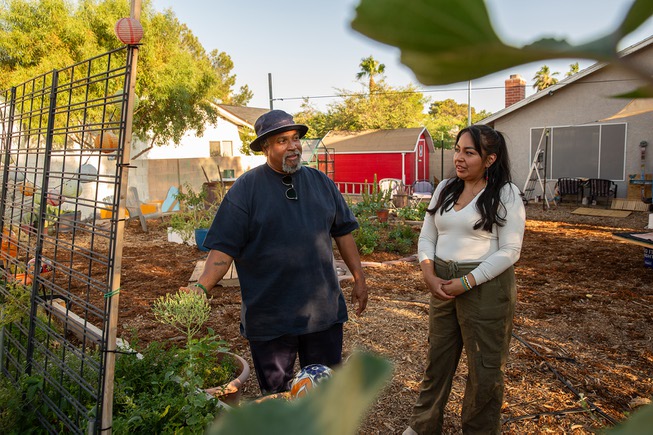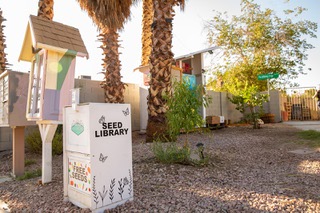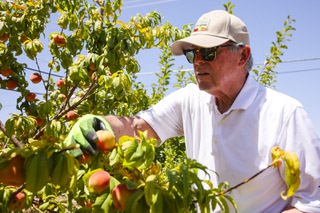
Peter Thomas and Victoria Flores talk about the positive impact their Solidarity Fridge and Giving Garden has had on the community Thursday July 6, 2023.
Sunday, July 23, 2023 | 2 a.m.
Gardening in Southern Nevada is both a blessing and a curse for those possessing a green thumb. While enjoying a long growing season, desert gardeners must also nurture their plants through the searing summer heat however they can.
With temperatures already climbing to 116 degrees this year, that means extra water, providing shade, mulching and keeping fingers crossed for any relief from the heat and for the occasional rain.
Victoria Flores said she was a little wary to square off with the blazing sun when she decided to start a community garden.
“I was intimidated, but I had support,” said Flores, who oversees the Giving Garden, which opened in 2022 in east Las Vegas. “People were like, ‘Look, stuff is going to die, but you can’t successfully do anything if you don’t try.’ So I learned to grow with the seasons. I learned by failing.”
Las Vegas’ growing season stretches from the middle of February to the end of November, or 285 days, according to the National Gardening Association. For comparison, Reno’s lasts 135 days, Elko’s lasts 93 days and Mesquite’s lasts 201 days.
Flores, who also founded the Solidarity Fridge food pantry in 2021, decided to launch the garden in her backyard last year.
After local nonprofit Nevada Plants donated fig, almond, pomegranate and almond trees to the food pantry, Peter Thomas was among the volunteers who showed up for the planting. He and Flores hit it off and started hashing out plans for what would become the Giving Garden.
They started by covering Flores’ backyard in soil and mulch, and planting trees to provide shade. By strategically planting taller shade crops with shorter herbs and flowers, the plants could provide cover and enrichment for each other. Step into the Giving Garden, and the temperature drops by several degrees because Flores’ strategic use of shade and the plants themselves, which combat the Urban Heat Island Effect.
“One of the first things we need to do out here is condition the soil,” Thomas said. “So pretty much anything new you can put into the ground that will take root is going to add to that biodiversity that’s going to be necessary for the future health of the garden.”
Thomas built the first two raised, wooden beds in the backyard. Today, the garden is a patchwork of raised beds, repurchased containers and brick-lined beds in the soil.
“I try to help out as much as I can over here, but most of the time we’re stretched kind of thin,” Thomas said. “It’s doable right now, but as the garden is beginning to grow more and more, I know she would benefit from more help.”
Flores says she wants to expand to a bigger community garden somewhere on the city’s east side and eventually establish a farmers market.
Other gardeners face the same challenges. The UNLV Community Garden has been around since 2015, but summer is a slow time, garden coordinator Andie Davis said.
Most of the student organizations with plots intend to maintain them through the summer, but participation always drops off once the spring semester ends, Davis said.
“The way our semesters are structured, unfortunately, they don’t really correspond to growing seasons,” Davis said. “So the community garden is still open for folks that have and would like to keep taking care of those, but even though every one of our plot holders said they were going to be active over summer, that’s kind of not the case.”
Even so, the garden is doing well thanks to some heat-proofing measures, Davis said.
This year, someone donated hay bales to the Rebel Recycling Center that the garden used for mulch. The straw covering helps the raised beds maintain moisture.
In September, the garden received funding for a new drip irrigation system to replace a less-efficient spray irrigation system that lost more water to evaporation daily.
“I think the only thing we could do better to mitigate heat issues is to put shade over it,” Davis said. “Unfortunately, we just haven’t got the funding to allow us to do that yet.”
The garden is home to 41 raised plots reserved by a combination of student groups, university departments and employee groups.
The plots are made from recycled cinder blocks and lumber. Produce from four of the plots supply UNLV’s food pantry, and most gardeners choose to donate from their own plots.
Davis said the garden’s location next to the Rebel Recycling Center on the edge of campus means few people stumble onto it. She said relocating to a more central location is one of her dreams.
“It’s probably a good 15-minute walk from the center of campus, and most students don’t want to do that,” she said.
Provident Community Garden in west Las Vegas has been around since 2012 but moved to a new location in 2017.
Garden members, volunteers and master gardeners worked together to move 90 beds and a fruit orchard from one side of West Oakey Boulevard to the other, near Mountain View Church.
The 47 members of the garden pay a $10 monthly fee for their plots, which covers the cost of water and dirt. Each plot is equipped with a spigot, but it’s up to gardeners to install their own drip irrigation system and timers.
The garden is also home to a 40-tree orchard with nectarines, peaches, lemons, apples, pomegranates and other fruits. About half of those trees came from the original garden.
“It was quite the thing to transport fruit trees in August from one garden to another,” garden association member Judy Tobler said. “We lost less than half. I mean, it was monumental, but we had a lot of help, and it was a lot of work.”
The original location had about twice as many raised beds, but the association made a conscious choice to keep the garden smaller to cut down on water use, Tobler said.
Tobler said garden membership was low after the move until 2020, when the coronavirus pandemic spurred increased interest in gardening.
“We have a waiting list of people trying to get in here,” Tobler said.
Garden President Todd Toresdahl said the association kept records of monthly water use, which doubles in summer.
“I’m a little conservative on our growth to make sure we don’t grow too much and wouldn’t be able to supply the water that we needed,” Toresdahl said. “It would be nice to have more beds and more members … and we’ll just have to see on that, I guess.”
Provident’s water supply comes from Mountain View Seventh Day Adventist Church. Toresdahl said the garden was close to using the maximum amount it can under the arrangement.
“The great thing about gardening in Nevada is that you can garden year-round, even in the heat of the summer,” Toresdahl said.
Sweet potatoes, beans, okra, eggplant and zucchini all thrive in the heat, he said.
Gardeners are at the tail end of harvesting tomatoes planted in March. In August, they’ll be able to start planting more vegetables.
Heirloom corn from the Springs Preserve grows alongside tomatoes and sweet potatoes in the community beds, which are specifically for donations to area church food banks.
Sheets of silver metallic plastic “mulch” line the community beds and help keep moisture from the drip irrigation system from evaporating too quickly. It doubles as a bug deterrent.
Some gardeners install shade cloths or hoop houses over their plots, while others use a fine netting to keep bugs off their plants.
Quails and other birds habitually raid the garden, sniffing out barely ripe fruit and tearing it to shreds before the gardeners can pick it.
“We’re trying to figure a way to get around them, but we haven’t been successful,” Tobler said.
Keith Thomas, another association member, said one year they used netting to protect the fruit trees, but it was labor intensive and will only get more difficult as the trees grow taller.
[email protected] / 702-948-7836 /
@Missmusetta


